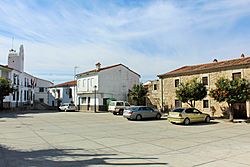Villar de Plasencia facts for kids
Quick facts for kids
Villar de Plasencia
|
||
|---|---|---|
|
||
| Country | Spain | |
| Autonomous community | Extremadura | |
| Province | Cáceres | |
| Area | ||
| • Total | 25.2 km2 (9.7 sq mi) | |
| Elevation | 470 m (1,540 ft) | |
| Population
(2018)
|
||
| • Total | 234 | |
| • Density | 9.29/km2 (24.05/sq mi) | |
| Time zone | UTC+1 (CET) | |
| • Summer (DST) | UTC+2 (CEST) | |
| Website | www.villardeplasencia.es | |
Villar de Plasencia is a small town in the province of Cáceres, located in the Extremadura region of Spain. It covers an area of about 25 square kilometers and had a population of 234 people in 2018. This town is known for its rich history and beautiful natural surroundings.
Contents
Where is Villar de Plasencia?
Villar de Plasencia is found on the western side of a mountain range called Montes de Tras la Sierra in Extremadura. The weather here is subtropical, meaning it's generally warm. The average temperature throughout the year is about 14.5°C.
The natural plants in the lower areas are mostly sclerophyllous forests. These are forests with tough, leathery leaves, like those found on holm oaks and cork oaks.
The town shares its borders with several other places:
- To the west, it borders Guijo and Zarza de Granadilla.
- To the north, it borders Jarilla.
- To the south and east, it borders Cabezabellosa and Oliva de Plasencia.
A Look at Villar de Plasencia's Past
Villar de Plasencia is in the Valle del Ambroz region. Its history is very much shaped by two important old roads. One is the Roman Road, which connected the ancient cities of Astorga and Mérida. The other is the Cañada Real de la Vizana, a route used by shepherds to move their animals between the Asturian lakes and the lands of Badajoz. These roads were super important for the town's growth and changes over many centuries.
How Old is Villar de Plasencia?
The very first signs of people living in the area around Villar de Plasencia go back a long, long time. During the Bronze Age, which was thousands of years ago, people lived in caves or simple outdoor camps. They used basic stone tools.
Later, around 2000 BC, during the Copper Age, people started to settle down more. They built small, more permanent homes.
During the Iron Age, a group of people called the Vettones built small forts. You might still find parts of an old fort near the Parish Church of Villar de Plasencia. This spot was perfect for watching over the valley and controlling movement.
The Roman Influence
When the Romans took over the western part of Spain, they built the first towns. The Silver Route became a main road, and new towns like Cáparra grew up along it. Cáparra was a city that paid taxes to the Romans.
It's thought that Villar de Plasencia started as a "villae", which was a Roman country estate or farm. A villa near the current train station might have given the town its name. It also helped Cáparra control the water supply from a nearby spring and the health baths of Salugral.
The Middle Ages
After the Roman Empire, the Middle Ages brought new changes. When the Berbers arrived, the old Roman roads were used more for moving animals. Watchpoints were set up along the Plasencia fault line. The Silver Route, once a grand imperial highway, became less important, and the original Roman villas disappeared.
From the 16th to the 19th Centuries
From the 1500s to the 1700s, Villar de Plasencia grew slowly. Most people worked in agriculture, growing cereals and grapes.
In the 1800s, wars like the War of Independence and the Carlist Wars caused a lot of damage. But the town recovered. Towards the end of the 19th century, things got better when the Palazuelo-Astorga railway line was built. This helped trade and the local economy.
Modern Times: 20th and 21st Centuries
The 1900s were a time of growth for Villar de Plasencia. New buildings and public services made life better for the people living there.
In the 21st century, the town has focused on keeping its history and culture alive. They also want to attract tourists. People can enjoy hiking along the Silver Route and seeing the old Roman and Medieval ruins.
Important Buildings and Monuments
The most important building in Villar de Plasencia is the Parish Church of "Nuestra Señora de la Asunción" (Our Lady of Assumption). It's located on a flat area near the church. This church was built in the 1500s and shows influences of the late Gothic style. The Bishop of Plasencia, Vargas Carvajal, helped pay for it in 1524. You can see his family's coat of arms on the church tower.
Inside, the church has a main area with three sections. The roof is made of wood and has a pointed shape. The area around the altar has beautiful Mudejar woodwork, decorated with latticework.
The town also has two Baroque chapels, called hermitages. They are dedicated to the town's patron saints, "San Bartolomé" (Saint Bartholomew) and "San Antonio de Padua" (Saint Anthony of Padua). The first chapel is made of stone and has a dome. The second one is next to a bridge built in 1792 by Bishop José González Laso Santos de San Pedro. This town is also where the old royal road to Plasencia begins.
Images for kids
See also
 In Spanish: Villar de Plasencia para niños
In Spanish: Villar de Plasencia para niños





